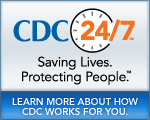MMWR – Morbidity and Mortality Weekly Report
MMWR News Synopsis for March 29, 2012
- State Cigarette Excise Taxes — United States, 2010a€“2011
- Assessing the Epidemiology Workforce in State and Local Health Departments — United States, 2010
- Caterpillar-Associated Rashes in Children — Hillsborough County, Florida, 2004a€“2011
- U.S. Food and Drug Administration Approval of an Extended Period for Administering VariZIG for Postexposure Prophylaxis of Varicella
There is a MMWR telebriefing scheduled for Noon E.T. on March 29, 2012 regarding the Surveillance Summary on autism prevalence.
1. State Cigarette Excise Taxes — United States, 2010a€“2011
CDC
Division of News & Electronic Media??????????????????????
(404) 639-3286
Increasing the price of cigarettes is one of the most reliable and effective ways to reduce smoking and prevent youth initiation. A newly published report by CDC found that in 2010 and 2011, eight states increased and one state decreased their cigarette excise tax.?? This is a noteworthy change from the last CDC report on this topic, when in 2009, 15 states increased their cigarette excise tax.?? The national average cigarette excise tax increased from $1.34 per pack in 2009 to $1.46 per pack in 2011. At the end of 2011 excise tax rates ranged from $0.17 per pack in Missouri to $4.35 per pack in New York.?? The evidence indicates that further increases in cigarette excise taxes would continue to reduce the demand for cigarettes, thereby preventing youth initiation, reducing cigarette consumption, and decreasing the prevalence of smoking, particularly among youth and young adults. States can reduce cigarette use even further by investing excise tax revenue in tobacco prevention and control.
2. Assessing the Epidemiology Workforce in State and Local Health Departments — United States, 2010
CDC
Council of State and Territorial Epidemiologists (CSTE)
Program Director
770-458-3811
Epidemiology provides the scientific basis for public health. The 2010 assessment of the epidemiology workforce in state and local health departments was undertaken to measure any variation in workforce size since 2009 given changes in state and federal public health funding.?? The 2010 assessment was the first time that a concurrent estimate of the number of epidemiologists working in both state and local health departments was performed. CSTE found that the number working in state health departments increased 12.9 percent from spring 2009 to fall 2010, mostly as a result of federal stimulus funding, and the number working in local health departments accounted for 34 percent of all epidemiologists working in state and local health departments.?? Future epidemiology assessments should include both the state and local epidemiology workforce.
3. Caterpillar-Associated Rashes in Children — Hillsborough County, Florida, 2004a€“2011
Florida Department of Health
Press Secretary
850-245-4111
Caterpillar exposure is a differential diagnosis for pruritic rash illnesses. Persons who have direct contact with certain types of caterpillars or who visit areas infested with caterpillars or their cocoons can develop rash that are often pruritic. Outbreaks of caterpillar associated rash illness have been reported in children in Hillsborough County, FL. Many of the affected children who sought medical care were misdiagnosed and children were also unnecessarily excluded from child care.?? It is important health care providers consider caterpillars and their cocoons as a differential diagnosis for rash illnesses during times of the year when the insect larvae are common.
4. U.S. Food and Drug Administration Approval of an Extended Period for Administering VariZIG for Postexposure Prophylaxis of Varicella
CDC
Division of News & Electronic Media??????????????????????
(404) 639-3286
In May 2011, the U.S. Food and Drug Administration (FDA) approved an extended period for administering VariZIG. VariZIG is a product recommended for people who do not have immunity to varicella (chickenpox), who are at high risk for severe chickenpox or complications, and who are ineligible to receive the chickenpox vaccine to protect them from getting chickenpox or to attenuate the severity of disease after being exposed to the virus that causes chickenpox.?? People at high risk for severe chickenpox are those with compromised immune systems, premature babies, or pregnant women.?? VariZIG is the only product of its kind available for use in the United States. The period after exposure to the chickenpox virus, during which a patient may receive VariZIG, is now 10 days; previously, it was 96 hours (4 days). As before, VariZIG should still be administered as soon as possible after exposure to the disease.
- Historical Document: January 6, 2011
- Content source: Office of the Associate Director for Communication, Division of News and Electronic Media
- Notice: Linking to a non-federal site does not constitute an endorsement by HHS, CDC or any of its employees of the sponsors or the information and products presented on the site.
View Press Releases in
Get e-mail updates
To receive e-mail updates about this page, enter your
e-mail address:
Contact Us:
- Centers for Disease Control and Prevention
1600 Clifton Rd
Atlanta, GA 30333 - 800-CDC-INFO
(800-232-4636)
TTY: (888) 232-6348 - Contact CDC-INFO


